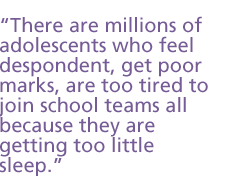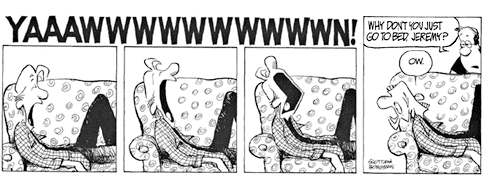|  | 
In making "Inside the Teenage Brain," we seemed to hit a nerve -- a parental one -- when we began looking into the world of teenagers and how they sleep. The patterns that young teens seemed to be experiencing -- an inability to go to sleep at night, followed by profound drowsiness on waking -- seemed so
pervasive that it should come as no a surprise that what parents were
seeing at home had already been corroborated in university sleep labs at
Stanford and Brown.
Reseachers had always believed that sleep was governed by what was called
the sleep-wake homeostasis, that is: "All other things being equal, ... the
longer one is awake, the greater the pressure for sleep to occur. ... This process
accounts for the increased need for sleep after staying awake all night." [1] It seemed perfectly reasonable that people
would want to sleep when they were very tired. But it didn't account for a
number of patterns that were obvious outside the lab: jet travellers woke up at
2 a.m. despite being exhausted after flying from Boston to London,
teenagers had trouble falling asleep though they also seemed to be very tired,
older people often woke up very early in the morning.

 The Biological Clock The Biological Clock
What researchers discovered is an internal biological clock, a clock that
sometimes acts against the sleep-wake cycle by keeping us alert when we should
be feeling tired. Sleep researchers Mary Carskadon, now at Brown
University, and Bill Dement at Stanford had seen this biological clock in action
when they tested a group of 10-12 year olds at Stanford. Dement, who pioneered sleep research at Stanford, wrote about
these experiments: "After centuries of assuming the longer we are awake, the
sleepier we will become and the more we will tend to fall asleep, we were
confronted by the surprising result that after 12 hours of being awake, the
subjects were less sleepy than they had been earlier in the same day,
and at the 10 o'clock test, after more than 14 hours of wakefulness had elapsed
...they were even less sleepy." [2]
The researchers found that the biological clock opposed the
sleep-wakefulness cycle at certain points of the day and at certain ages. It
kept people awake when they were very tired. Just before puberty, that internal
clock helped teens stay alert at night when they should have been falling
asleep. The researchers called this a "phase-delay."
| 
 |  | 
Sarah Spinks is an independent director and producer. She was with the Canadian Broadcasting Corporation for seventeen years where her documentaries won many awards. Spinks' last FRONTLINE documentary, "Making Babies," reported on state-of-the art infertility treatments. |
 |  |
 |  |
|
| 
The biological clock or circadian rhythms (from the Latin words "circa" and
"dies," or "around day") of smaller children don't show the same delays. Nothing is
opposing their need to sleep in the evening. Until the age of 10, many children
wake up fresh and energetic to start the day. In contrast, the biological
clock of pre-teens shifts forward, creating a "forbidden" zone for sleep around
9 or 10 p.m. It is propping them up just as they should be feeling sleepy.
Later on, in middle-age, the clock appears to shift back, making it hard
for parents to stay awake just when their teens are at their most alert.

Carskadon discovered other important patterns in adolescent sleep. By studying
alertness, she determined that teens, far from needing less sleep, actually
needed as much or more sleep than they had gotten as children -- nine and a
quarter hours. Most teenagers weren't getting nearly enough -- an hour and a half
less sleep than they needed to be alert. And the drowsiness wasn't only in the
early morning. Teens had a kind of sleep trough in the mid-afternoon and then
perked up at night, even though they hadn't had a nap.
Carskadon is now exploring the effect of light in setting adolescent sleep
patterns, for darkness seems to trigger the release of melatonin, often called
the "sleep" hormone. Measuring melatonin also helps researchers define the
different circadian rhythms of children, teens, and adults.

 Sleep Debt Sleep Debt
A great concern of sleep researchers is that teens are so
sleep-deprived. Bill Dement speaks about the huge sleep debt that many teens and adults carry around with
them every day. With most high schools in the U.S. starting around 7:20 a.m. and
with many teens going to bed between 11 and 12 p.m., sleep researchers worry that
teenagers are suffering an epidemic that is largely hidden. Since students are
often driving to school, to sporting events, and home from late-night parties,
this sleep debt holds huge risks. Many high school students know of someone, often a high-achieving kid, who on the drive back from a sporting
event or dance simply fell asleep at the wheel. On a less dramatic note, there
are literally millions of adolescents who feel despondent, get poor marks, or are too tired to join high-school teams all because they are getting too little
sleep. Because of their deep concern about these issues, sleep researchers
are pushing for later school start times and are trying to introduce
sleep issues into the high school curriculum.

 Sleep, Learning, and Memory Sleep, Learning, and Memory
The other area of sleep research relevant to teenagers, their parents, and
teachers is the effect of sleep on learning and memory. In experiments done at
Harvard Medical School and Trent University in Canada, students go through a
battery of tests and then sleep various lengths of time to determine how sleep
affects learning. What these tests show is that the brain consolidates and
practices what is learned during the day after the students (or adults, for
that matter) go to sleep. Parents always intuitively knew that sleep helped
learning, but few knew that learning actually continues to take place while a
person is asleep. That means sleep after a lesson is learned is as
important as getting a good night's rest before a test or exam.
This research is done by giving students a series of tests. The students are
trained, for instance, to catch a ball attached by a string to a cone-like cup.
As they repeat the skill during the test day, they are able do it faster and more
accurately. Let's say they go from catching a ball 50 percent to 70 percent of
the time over a period of half an hour. The students who get a good night's
sleep improve when they are retested. On a retest three days after they have a good night's sleep, they might catch a ball 85 percent of the time. The
other students who got less than six hours sleep either do not improve or
actually fall behind.
Some of the tests are more demanding. They are called cognitive procedural
tasks and they mimic what a student might learn in physics or math, or in
certain sports. They present the student with something new to be learned or
require an ability to conceptualize, to form a picture of the
task in their minds.

The brain consolidates learning during two particular phases of sleep.
According to Dr. Robert Stickgold of Harvard University Medical School, who
conducted a series of tests involving visual tasks, the brain seems to need
lots of slow-wave sleep and a good chunk of another kind of sleep, Rapid Eye
Movement, or REM. Dr. Stickgold hypothesizes that the reason the brain needs
these particular kinds of sleep is that certain brain chemicals plummet during
the first part of the night, and information flows out of the hippocampus (the
memory region) and into the cortex. He thinks the brain then distributes the
new information into appropriate networks and categories. Inside the brain,
proteins strengthen the connections between nerve cells consolidating the new
skills learned the day before. Then later, during REM, the brain re-enacts the
lessons from the previous day and solidifies the newly-made connections through
the memory banks.
What these studies show is that learning a new task, whether it is sports or
music, will be greatly helped by getting a good night's sleep and that students'
ability to remember things, be it a lesson on geometry or the causes of the
Second World War, is mediated by sleep.
The proposition that sleep aids the learning process is accepted by many
researchers. In a review of the Harvard studies, the late Chris Gilpin
described the research as "the most believable data ever collected that a
specific memory function is associated with sleep." However, a recent study
published in the November 2001 issue of the journal Science challenges that
conclusion. After conducting a literature review, Jerome M. Siegel of the UCLA
Department of Psychiatry and Brain Research and the Center for Sleep Research,
judged the evidence of a link between REM sleep and learning to be "weak and
contradictory." He pointed to inconsistent results from human and animal
studies, and argued that studies of humans who do not experience REM sleep (due
to brain injuries or pharmacological reasons) do not show memory problems.
Siegel concludes, however, that although he does not believe that the existing
literature points to a link between REM sleep and memory consolidation, "just
as nutritional status, ambient temperature, level of stress, blood oxygenation,
and other variables clearly affect the ability to learn, adequate sleep is
vital for optimal performance in learning tasks."

 Learning Good Sleep Habits Learning Good Sleep Habits
Putting good sleep habits into practice is particularly difficult for
teenagers. Not only do their own circadian rhythms fight against going to
sleep early, but many teens don't have any control over the time they wake up.
Teens can do something to try to bring their internal body clock forward.
Sleep experts say dimming the lights at night and getting lots of daylight in
the morning can help. Having a routine bedtime of 10 p.m., sleeping in a cool
environment and turning off music, the Internet, and televisions would help to
reset the body clock. And though sleeping in is a good thing, trying to get
up after only an extra hour or two is a lot better than "binge-sleeping" on the
weekends. If a student is used to getting up at 6:30 a.m., they
shouldn't sleep until noon on the weekend. That simply confuses their bodies.
And lots of sports helps, too -- better earlier in the day than late.
Sleep research not only points out the importance of sleep to teenagers, but
explodes some of the myths around sleep: principally the idea that people need
less and less sleep as they grow up. There are many factors in the lives of
adolescents that elude their control. Sleep is one area where the lessons are
clear and the benefits of following them are quickly apparent.
 [1] Mary Carskadon, "When Worlds Collide:
Adolescent Need for Sleep Versus Societal Demands", in Adolescent Sleep
Needs and School Starting Times, editor Kyla Wahlstrom, Phi Delta Kappa
Educational Foundation, 1999
[1] Mary Carskadon, "When Worlds Collide:
Adolescent Need for Sleep Versus Societal Demands", in Adolescent Sleep
Needs and School Starting Times, editor Kyla Wahlstrom, Phi Delta Kappa
Educational Foundation, 1999
[2] William C. Dement, The Promise of Sleep,
Dell Paperback 1999, p. 85

home + introduction + from zzzs to a's + work in progress + seem like aliens? + science
discussion + producer's chat + interviews + video excerpt + watch online
tapes & transcripts + press reaction + credits + privacy policy
FRONTLINE + wgbh + pbs online
some photographs copyright ©2002 photodisc. all rights reserved
web site copyright WGBH educational foundation
|  |